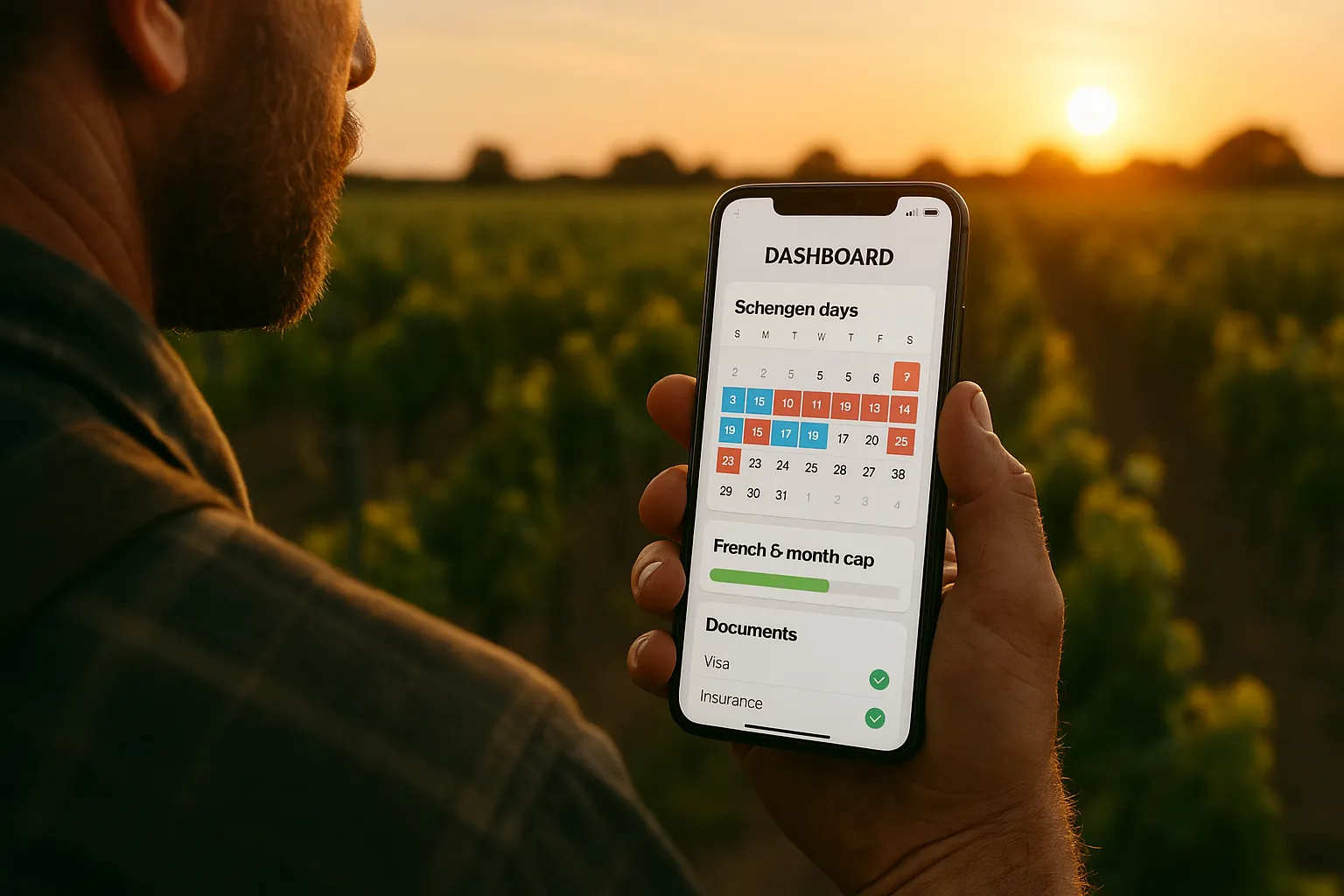Seasonal Worker Re-Entry: Managing Multiple Short-Stay Authorizations

France’s booming agriculture, tourism and construction sectors all rely on tens of thousands of foreign seasonal workers who come for a few weeks or months, fly home, and return the following year. Since 2024 the legal framework has tightened: carriers must verify every stamp, the Schengen Entry/Exit System (EES) is scheduled to launch in late-2025, and prefectures cross-match departure data before issuing the next authorisation. Getting a first “travailleur saisonnier” visa is only half the battle—the real challenge is organising safe, timely re-entry for each new season without overstaying the cumulated short-stay limit or triggering an OQTF. This guide explains how multiple short-stay authorisations work, the 90 / 180-day rule, how to prove you respected previous exit dates, and the practical steps to secure a fresh authorisation (autorisation provisoire de travail or APT) every time you are needed in France.
1. Seasonal worker status in a nutshell
Under Articles L425-10 to L425-13 of the French immigration code (CESEDA), a “seasonal worker” is a third-country national hired for a job that recurs at roughly the same period each year, for example grape harvests, ski-resort housekeeping, campsite animation or coastal restaurant service. Key features:
- The initial D visa states “travailleur saisonnier” and can remain valid up to 3 years.
- Each stay inside France must not exceed six months in any 12-month period.
- During that timeframe the worker may enter and leave France multiple times, provided each assignment is covered by a prefecture-issued APT and the cumulated presence stays within the six-month cap.
- A multi-year “carte de séjour saisonnier” (residence permit) can replace the visa after 3 years of repeated work, but holders must still spend at least six months per year outside France.
2. The double time calculation you must master
Many newcomers confuse two separate clocks that run in parallel:
- Schengen short stay: You may circulate visa-free within the 26 Schengen states for up to 90 days in any rolling 180-day window (Article 6.1 Schengen Borders Code). Days as a seasonal worker inside France count toward this total.
- French seasonal cap: Regardless of Schengen hops, your days on French soil may not exceed six months per 12-month period starting from your first entry in a given year.
Fail either test and you risk refusal of your next APT, airport refusal of entry, or—worst case—an OQTF and re-entry ban. Use a spreadsheet or a dedicated 90/180 app to record every overnight stay inside Schengen so you can prove compliance at any control.
| Key metric | Limit | Who enforces it | Must stay outside? |
|---|---|---|---|
| Schengen presence | 90 days per 180 | Border police (EES) | Any non-Schengen country |
| Seasonal work presence in France | 6 months per 12 | Prefecture & labour inspectorate | Outside France (can be Schengen)* |
*Example: A Spanish holiday counts as “outside France” for the seasonal cap but still burns Schengen days.
3. Planning the calendar: three typical scenarios
- Harvest specialist: Works 50 days (Sept-Oct) picking grapes and olives, returns home 10 Nov. Next entry cannot be earlier than 11 Mar of the following year without breaching the 6-month cap. Only 50 Schengen days consumed.
- Ski instructor: Works 89 days (15 Dec-14 Mar). Any leisure weekend trip to Italy cancels the margin. Must leave Schengen on day 90 or obtain a long-stay permit.
- Rotating hospitality worker: Two assignments—75 days in summer campsite, back home 30 Aug, plus 60 days Christmas market job 15 Nov-13 Jan. Total 135 days Schengen in 180 days—illegal. Solution: split contracts by cutting weeks or apply for a Passeport Talent HCR long-stay permit under the 2025 quota system.
4. Securing each new APT online
Since January 2025 all employers must request seasonal work authorisations through the ANEF-Emploi portal (Decree n° 2024-1712). Processing times average 5-10 working days. Checklist for the employer:
- Employment contract indicating exact dates, gross wage above sector minimum.
- Proof of accommodation provided or certified by the employer.
- Confirmation that social contributions were paid during previous seasons (URSSAF attestation).
- Copy of your stamped passport pages proving timely exits.
Ask the HR manager to upload your existing visa or residence-permit scan; ANEF will cross-check validity automatically.
5. Preparing your personal re-entry file
Border officers now have EES but may still ask you to justify the purpose and duration of stay. Carry:
- Original APT PDF with QR code.
- Two printouts of your employment contract and last payslip from previous season.
- A Schengen day-count table highlighting remaining allowance.
- Proof of accommodation (attestation d’hébergement or hotel booking).
- Ongoing travel insurance covering medical care.
ImmiFrance’s clients can generate a one-page “seasonal compliance summary” via the dashboard, consolidating stamps, ANEF approvals and day-counters, which speeds up checks.

6. Common pitfalls that derail future seasons
- Overlapping contracts: Accepting two French contracts that overlap—even by one day—voids both APTs.
- Unregistered exit: Leaving via a land border where your passport is not stamped can make it impossible to prove compliance. Keep plane or ferry tickets as fallback evidence.
- Early return after illness: If you cut an assignment short due to injury, inform the prefecture and upload medical proof in ANEF to adjust the day counter; otherwise the full contract period is still recorded.
- Prefecture backlog: Renewal of the multi-year card can take 3-4 months. If your card is expiring before next entry, use the “renewal filing receipt” (récépissé) as substitute but only if issued less than three months before travel. See our article “Traveling Inside Schengen with a French Residence Permit: Rules and Tips” for checklist.
7. Switching tracks: when short-stay authorisations are no longer enough
Repeated 90-day juggling becomes impractical for high-skill or multi-site workers. The 2025 Immigration Reform introduced faster upgrades:
- Passeport Talent Monde – Seasonal Supervisor: 1-4 year permit for team leaders earning ≥1.3 × SMIC. Counts as long-stay; no six-month cap.
- Work-regularisation quota: If you log 24 payslips over three seasons you may apply for “Accueil métiers en tension” under the 2025 quota, a route explained in our guide “From Undocumented to Documented: Step-By-Step Regularization Through Employment”.
- Temporary Worker VPF: Spouses and minor children can request a “vie privée et familiale” card after 18 months of compliant seasonal work, ending family-separation cycles.
8. Timeline and action plan before every season
| Months before start | Worker to-do | Employer to-do |
|---|---|---|
| ‑4 months | Check passport validity (≥15 months). Audit day counter. | Draft employment contract. Forecast accommodation slots. |
| ‑3 months | Collect exit proofs from previous season. Renew travel insurance. | File APT in ANEF-Emploi with supporting docs. |
| ‑2 months | Book visa appointment if initial D visa will expire mid-season. | Track APT status, respond to prefecture queries within 48 h. |
| ‑1 month | Purchase refundable flight. Download APT PDF, contract, insurance. | Send welcome briefing on health & safety. |
| ‑1 week | Print compliance folder, verify Schengen remaining days. | Confirm airport pickup or housing key handover. |
9. How ImmiFrance can secure seamless re-entries
Even diligent workers see rules evolve mid-season: biometric pilots, airline carrier alerts, prefecture strikes. As an ImmiFrance client you benefit from:
- Real-time EES impact alerts pushing to your phone when a new rule or border test goes live.
- A multi-season dashboard that syncs with ANEF files, day counters and passport scans to flag upcoming overloads.
- Emergency lawyer hotline if a carrier or officer questions your calculations at departure or arrival.
- Employer interface to pre-populate APT fields and deposit URSSAF proof, cutting submission errors that cause refusals.
Book a free 15-minute call to see how our 92 % first-time APT approval rate keeps your seasonal income flowing while protecting a future path to long-term residency.

10. Key takeaways
- Track both Schengen 90/180 days and the French six-month cap; they are not the same.
- Make sure each assignment is covered by a fresh ANEF-issued APT, even if your multi-year visa/card is still valid.
- Collect exit evidence—unstamped land exits are the number-one cause of re-entry problems.
- Consider upgrading to a long-stay permit after three high-intensity seasons to remove short-stay math.
- ImmiFrance’s digital tools and lawyer network can safeguard every step—from day counting to emergency defence if the prefecture challenges your record.
Stay compliant, keep earning, and turn seasonal work into a gateway to secure residency rather than a revolving-door risk. Visit immifrance.com/consultation to get personalised advice before your next flight.
